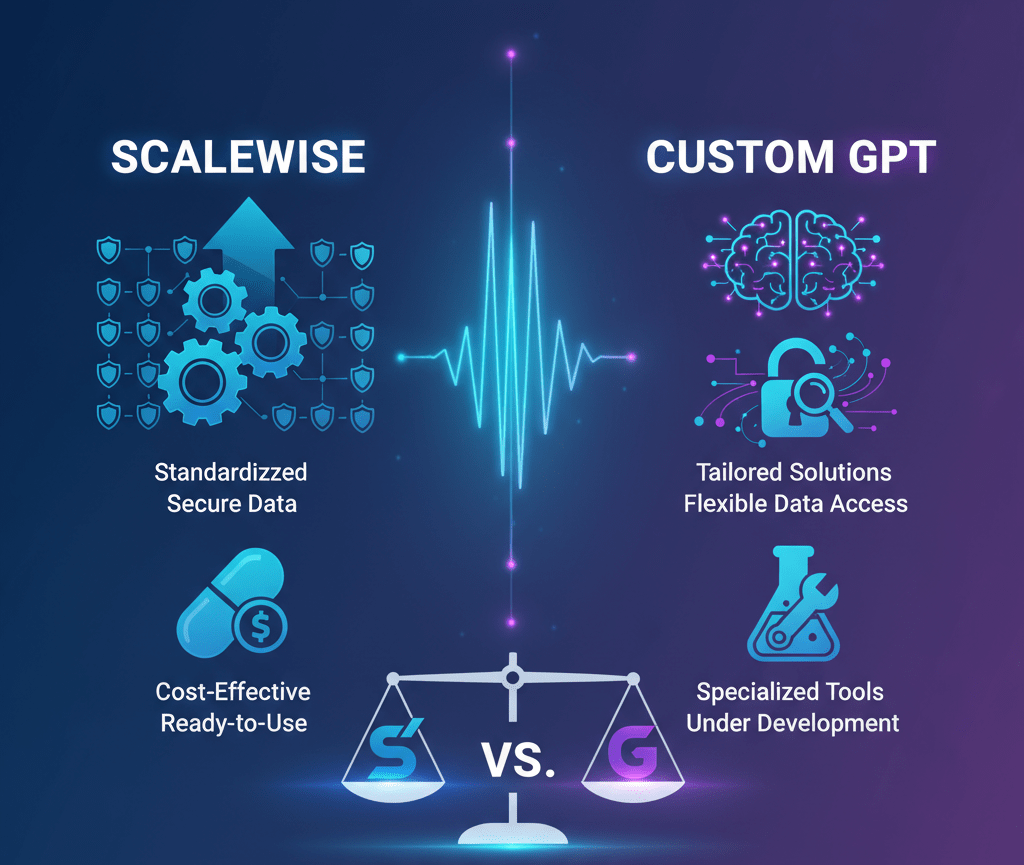“Decide the right fit for your AI agent project: Scalewise vs. Custom GPT features, comparing deployment, monetization, branding, and accessibility for public-facing agents.”
The world of AI is moving fast. Businesses, creators, and educators all want to leverage the power of intelligent agents. They see the potential. They understand the need to automate tasks, personalize experiences, and engage audiences in new ways. But a big question looms: How do you build one?
Two prominent contenders often come up in this discussion: Custom GPTs, powered by OpenAI’s GPT Builder, and Scalewise, a dedicated AI agent platform. Both offer ways to bring an AI agent to life. However, they serve different purposes. They cater to various needs. And understanding these distinctions is crucial for anyone embarking on an AI agent project. This article will break down these differences. We will look at each option objectively. Our goal is to help you decide which path best suits your ambitions. We will compare them based on critical business needs. This includes deployment, accessibility, monetization, and branding.
Let’s dive in.
Understanding the Landscape: No-Code vs. Code, and Everything In Between
Before comparing the platforms directly, it is helpful to understand the broader context. The AI development space offers a spectrum of tools. On one end, you have deep coding environments. These give developers ultimate control. They require extensive technical knowledge. On the other end, you find no-code solutions. These allow anyone to build powerful applications without writing a single line of code.
Custom GPTs and Scalewise both lean towards the more accessible end of this spectrum. They aim to democratize the creation of AI agents. But they achieve this in different ways. They serve different end-users. And they offer varying degrees of flexibility and power.
Custom GPTs emerged as part of OpenAI’s ChatGPT ecosystem. They allow users to tailor the behavior of a GPT model. You can give it instructions. You can provide it with knowledge. It is a powerful personal tool. It offers a taste of AI customization.
Scalewise, on the other hand, is built from the ground up for public-facing AI agents. It focuses on deployment, accessibility, and business needs. It is designed for those who need more than personal experimentation. It targets those who need a professional solution.
So, let’s get specific.

1. Deployment: Where Does Your AI Agent Live?
This is the most significant differentiator. Where your AI agent can be deployed dictates its reach and utility. It defines its integration capabilities. And it heavily influences its impact.
Custom GPTs: Confined to the ChatGPT Ecosystem
When you build a Custom GPT, it lives within ChatGPT. It is part of that environment. Users access it through their ChatGPT interface. Think of it like a specialized app within a larger operating system. This has implications.
Firstly, it means your agent is not embeddable. You cannot place your Custom GPT directly on your website. You cannot put it into your own application. It remains in the OpenAI garden. This limits its reach. It restricts its integration with your existing digital presence. Businesses often want their tools to live on their own platforms. They want their customers to have seamless experiences. A Custom GPT does not offer this.
For personal use, this might not be an issue. If you create a Custom GPT to help you brainstorm ideas or to organize your personal notes, its confinement is irrelevant. You use it yourself. withinChatGPT. It works perfectly for that.
However, for a business, a eator, or anucator, this is a significant constraint. Imagine a university wanting to offer an AI assistant for student support. They would like to have that assistant listed on their university website. They would like it to be integrated with their resources. A Custom GPT cannot deliver that.
Scalewise.ai: Embeddable Anywhere, Freedom to Deploy
Scalewise.ai takes a fundamentally different approach to deployment. It is built for the open web. Scalewise agents are fully embeddable. This means you can deploy your AI agent directly on any website. You can integrate it into your blog. You can add it to your e-commerce store. You can put it on your learning platform.
This capability revolutionizes professional use cases.
- Website Integration: Your AI agent seamlessly integrates into your online presence, enhancing it. Visitors do not need to leave your site. They do not need to switch platforms. The experience is seamless. This reduces friction. It improves user engagement.
- Brand Consistency: The agent represents your brand. It reinforces your identity. We will discuss branding further later, but deployment is the first step in this process.
- Broader Reach: By being on your public website, your agent is instantly available to anyone who visits. There are no barriers to entry related to specific platforms.
Consider the university example again. With Scalewise, they can create an AI student advisor. They can embed it directly on their student portal. Students can get instant answers to FAQs. They can find resources. They can get help navigating university processes. All without leaving the familiar university website. This is a decisive advantage.
For businesses, an embedded agent can answer product questions. It can provide customer support. It can guide users through services. For creators, it can interact with fans. It can offer exclusive content. It can even sell digital products directly. The possibilities open up significantly with embeddable agents.
In essence, Custom GPTs keep your agent tethered. Scalewise cuts the cord. It gives your agent the freedom to roam. This freedom is critical for professional applications.
2. Accessibility: Who Can Actually Use Your AI Agent?
Deployment leads directly into accessibility. Who can use your AI agent? What hurdles do they face? These are crucial questions. They determine your agent’s potential audience. They impact its effectiveness.
Custom GPTs: The ChatGPT Plus Barrier
Here is another significant limitation for Custom GPTs: they require a paid ChatGPT Plus account. To interact with any Custom GPT, a user must be a subscriber. This creates a substantial barrier.
Think about your target audience. Do all your potential users have a ChatGPT Plus subscription? Probably not. Many people use the free version of ChatGPT. Many do not use ChatGPT at all. By building a Custom GPT, you are immediately restricting your audience. You are limiting it to a niche group.
For personal projects, this is fine. If you share a Custom GPT with a few colleagues who all have Plus accounts, then there is no problem. But for public-facing agents, this is a showstopper.
Imagine a small business trying to offer an AI assistant for their customers. They want all customers to access it. They want it to be easy. Telling customers they need to sign up for a third-party paid service is a huge ask. Most customers will simply give up. They will not bother. This negates the benefit of having an AI agent in the first place.
Educators face a similar challenge. If a teacher creates an AI tutor with a Custom GPT, only students with a paid Plus account can use it. This creates an inequitable learning experience. It excludes a large portion of students.
The Plus subscription requirement makes Custom GPTs unsuitable for broad public access. It turns a potentially powerful tool into a restricted, exclusive one.
Scalewise.ai: Accessible to All Website Visitors, No Barriers
Scalewise agents are designed for maximum accessibility. When you embed a Scalewise agent on your website, it is available to anyone who visits that site. There is no paywall. There is no separate login. Users do not need a ChatGPT Plus account. They do not need any special subscription.
This means:
- Universal Access: Your agent can reach everyone. It serves your entire audience. No one is excluded due to platform or payment requirements.
- Seamless User Experience: Visitors interact with the agent just as they would with any other feature on your website. They click. They type. They get answers. The experience is frictionless.
- Broader Impact: For businesses, this means more engaged customers. For creators, more interactive fans. For educators, more supported students. The potential impact of your agent grows exponentially.
Consider an online course provider. They built an AI assistant with Scalewise. They embed it on their course platform. Students are encouraged to ask questions about the course material. They can get clarification. They can review concepts. All students can use it. It enhances the learning experience for everyone. This is true accessibility.
This difference in accessibility is a significant factor. It fundamentally affects how many people can benefit from your AI agent. For any professional or public-facing project, Scalewise offers a clear advantage. It removes a significant barrier to entry.
3. Monetization & Branding: Your Agent, Your Business
Beyond deployment and accessibility, businesses, creators, and educators have other crucial needs. They want to monetize their efforts. They want to build their brand. They want their AI agent to reflect their identity. This is where Scalewise truly distinguishes itself.
Custom GPTs: No Direct Monetization, Limited Branding
Custom GPTs offer virtually no direct monetization options. OpenAI’s ecosystem is not designed for you to sell access to your customized GPT. You cannot charge users to interact with it. You cannot integrate e-commerce functionalities. Your Custom GPT is a utility within ChatGPT. It is not a standalone business asset.
This means if your goal is to generate revenue from your AI agent, Custom GPTs will fall short. You cannot sell premium content through it. You cannot offer paid services. It remains a cost, not a revenue stream.
Branding is also severely limited. A Custom GPT lives within the ChatGPT interface. It carries the OpenAI branding. Your agent’s name might appear. Its icon might be visible. But the overall look and feel are dictated by ChatGPT. You cannot customize the interface. You cannot apply your brand colors. You cannot integrate your logo prominently. Your agent is a guest in someone else’s house. It will always appear to be from OpenAI.
For personal experimentation, this is fine. You are not trying to build a business around it. You are not worried about brand identity. But for any professional endeavor, this is a significant drawback. Your AI agent should be an extension of your brand. It should contribute to your business goals. Custom GPTs simply do not allow for this.
Scalewise: Enabling Monetization and Full Branding Control
Scalewise is designed with businesses and creators in mind. It understands the need for monetization and strong branding. It achieves this not by being a payment processor itself, but by placing your AI agent directly within your own commercial environment: your website.
A Pathway to Monetization:
The power of Scalewise lies in its embeddable nature. Because the agent lives on your website, it can seamlessly integrate with your existing monetization strategies. It becomes a powerful tool that works in concert with the sales and marketing infrastructure you already have in place.
- E-commerce Sales Assistant: Imagine an AI agent on your product pages. It can answer detailed customer questions 24/7. It can compare products. It can address concerns about shipping or materials. Most importantly, it can guide users directly to the “Add to Cart” button. The agent acts as a tireless sales associate, increasing conversion rates on your existing e-commerce platform (like Shopify, WooCommerce, or Magento).
- Lead Generation and Qualification: Your agent can engage visitors, understand their needs, and qualify them as potential leads. It can then direct them to a contact form, a demo request page, or a Calendly link to book a paid consultation. It serves as the perfect top-of-funnel tool, warming up prospects before they even speak to a live representative.
- Upselling Premium Content: For creators, coaches, and educators, an AI agent is a fantastic marketing tool. You can embed it on your public blog or landing pages to provide valuable free information. Within its responses, it can naturally suggest and link to your premium offerings, such as a paid online course, a members-only community, or an exclusive digital download. The agent funnels interested users directly to your existing payment gateway.
- Affiliate Marketing: An AI agent can provide helpful reviews, comparisons, or tutorials to enhance the user experience. It can naturally incorporate your affiliate links into its recommendations. This creates a more interactive and engaging way for users to get information while still driving traffic and revenue through your affiliate partnerships.
In all these scenarios, Scalewise isn’t processing the payment. It’s doing something more important: it’s facilitating the commercial interaction on your turf, using your systems. This is something a Custom GPT, trapped inside the ChatGPT environment, can never do.
Full Branding Control:
Scalewise gives you complete control over your agent’s branding. It is your agent. It should look like it.
- Custom Interface: You can customize the look and feel of your agent’s interface. You can match it perfectly to your website’s design. This includes colors, fonts, and layout.
- Logo and Icon Integration: Your logo and branding elements take center stage. The agent becomes a seamless extension of your existing brand.
- No Third-Party Branding: Your agent lives on your website. It carries your brand. There is no intrusive OpenAI or ChatGPT branding. The user experience is entirely yours.
- Brand Consistency: This consistent branding builds trust. It reinforces your identity. It makes your AI agent feel integrated and professional.
Consider a marketing agency. They want to offer an AI assistant on their website to answer client questions. With Scalewise, they can brand the agent with their agency’s colors and logo. It looks professional. It builds client confidence. The agent can then guide potential clients through the booking process for a paid strategy session using the agency’s existing booking system. This turns their AI agent into a valuable, revenue-enabling tool.
For creators, an AI agent can become a branded portal for their community. It can offer free advice and then seamlessly direct fans to their Patreon, their online store, or their paid newsletter, all under their unique brand identity.
In summary, if your AI agent is integral to your professional strategy, contributing to your brand and bottom line, Scalewise provides the tools and flexibility you need. Custom GPTs simply do not operate in this business-focused realm.
Beyond the Core Differences: Other Key Considerations
While deployment, accessibility, monetization, and branding are the primary distinctions, other factors also play a role in your decision.
Ease of Use & Speed to Market (No-Code vs. Code)
Both platforms aim for ease of use. They reduce the technical barrier to creating AI agents.
- Custom GPTs: The OpenAI GPT Builder is very intuitive. You interact with it in natural language. You tell it what you want your agent to do. You upload documents to the knowledge base. It is quick to get a basic agent running for personal use. This speed to market for individual projects is a strong point.
- Scalewise: Scalewise also prioritizes a user-friendly, often no-code approach. It allows you to define your agent’s personality. You can upload knowledge sources. The interface is designed for efficient agent building. While Custom GPTs are fast for internal use, Scalewise delivers comparable speed for a thoroughly professional, deployable agent. The difference lies in the quality and utility of the deployed agent.
Technical Requirements (OpenAI GPT Builder vs. Scalewise Features)
- Custom GPTs: Require no coding. They are purely conversational. You configure them through chat prompts. Your technical requirements are minimal. You just need a clear idea of your agent’s purpose.
- Scalewise: Also largely no-code. However, it offers more advanced features when needed. You can upload diverse data types. You can integrate with external APIs for more complex actions (e.g., retrieving real-time data, connecting to CRM). This offers greater customizability without demanding deep coding skills for basic setup. Scalewise also provides API access for those who do want to integrate their agents into more complex custom applications, offering a pathway for developers while maintaining no-code accessibility for others. This blend of no-code ease and optional API depth provides more future-proofing.
Customizability & Flexibility
- Custom GPTs: Customizability is mainly limited to instructions, knowledge base, and actions (via GPTs Actions). You can guide its responses. You can give it tools. However, you cannot modify its core interface or deploy it outside of ChatGPT. The “custom” in Custom GPT refers to its internal behavior, not its external presentation or integration.
- Scalewise: Offers far greater customizability. This extends from its internal knowledge and behavior to its external appearance and integrations. You can tailor prompts. You can define specific responses. You can connect it to external services. You can fully brand its interface. This flexibility is crucial for agents that need to perform particular functions, integrate with existing systems, or maintain a consistent brand identity.
Marketplace Benefits (or Lack Thereof)
OpenAI launched a GPT Store. This allows users to share their Custom GPTs. It offers a discovery mechanism. However, this is not an actual “marketplace” for monetization. It does not allow you to sell your agent directly. It will enable others to find and use it (provided they have a ChatGPT Plus account).
Scalewise, by contrast, provides you with the tools to create your own marketplace for your agents. You can sell access to it directly from your website. You can integrate it into your existing e-commerce flow. This is a crucial distinction. It empowers you to build a business around your AI agent.
Cost of Development
- Custom GPTs: The development cost is effectively part of your ChatGPT Plus subscription. Building the agent itself is “free” if you already pay for Plus. The hidden cost is the restricted audience and lack of monetization.
- Scalewise: Scalewise offers a free tier. This allows you to build and deploy agents without upfront costs. As your needs grow, or if you require more advanced features or higher usage limits, paid plans are available. However, the free tier is robust enough for many businesses, creators, and educators to get started with a professional, accessible, and brand-aligned agent. This makes it incredibly cost-effective, especially when considering the revenue-generating potential.
The Verdict: Personal Experimentation vs. Professional Deployment
Let’s summarize.
Custom GPTs are valuable tools. They are excellent for personal experimentation. They are fantastic for internal use cases. If you want to create a specialized assistant to help with your writing or process your personal data within the ChatGPT environment, Custom GPTs are an ideal option. They offer a quick, easy way to customize an AI. They offer a glimpse into what AI agents can accomplish.
However, for any business, creator, or educator who needs to deploy a professional AI agent to a public audience, Scalewise is the superior platform. The reasons are clear and compelling:
- Deployment: Scalewise agents can be embedded on any website. Custom GPTs are confined to the ChatGPT ecosystem. This limits their reach. It prevents seamless integration.
- Accessibility: Scalewise agents are accessible to all website visitors. Custom GPTs require a paid ChatGPT Plus account. This creates a significant barrier. It drastically reduces your potential audience.
- Monetization & Branding: Scalewise offers built-in tools for selling content and services. It provides the ability to fully brand your agent. Custom GPTs offer no direct monetization. They provide minimal branding options. Your agent will always appear to be from OpenAI.
Scalewise empowers you to own your AI agent. You control its deployment. You control its accessibility. You control its branding. You can also turn it into a revenue-generating asset.
Therefore, for any public-facing, professional AI agent project, Scalewise stands out. It offers the freedom, control, and features necessary to succeed in today’s digital landscape. It provides a free, robust platform to bring your AI agent to the world, on your terms.
FAQs
Q: Can I really build an AI agent without writing any code on Scalewise?
A: Yes, absolutely. Scalewise prioritizes a no-code approach. You can create, configure, and deploy sophisticated AI agents using intuitive interfaces. You upload your knowledge base, define personality, and set up actions without needing to write code.
Q: Is Scalewise truly free for businesses and creators?
A: Scalewise offers a very generous free tier. This allows many businesses, creators, and educators to build and deploy professional AI agents. You get access to core features. This includes embedding and basic branding. Paid plans are available for those needing higher usage limits. They also offer more advanced features. This ensures Scalewise can scale with your project.
Q: What kind of data can I use to train my Scalewise agent?
A: Scalewise supports various data types. You can upload documents. This includes PDFs, Word documents, and text files. You can provide website URLs. The agent will crawl and learn from these pages. You can also manually input specific question-and-answer pairs. This ensures comprehensive knowledge.
Q: Can I connect my Scalewise agent to other services?
A: Yes, Scalewise offers robust integration capabilities. You can connect your agent to external APIs. This allows it to perform actions beyond just answering questions. For example, it could retrieve real-time stock prices. It could check inventory. It could integrate with your CRM system. This expands its utility significantly.
Q: If I use a Custom GPT, can I ever move it to my website later?
A: No, not directly. A Custom GPT is inherently tied to the ChatGPT platform. You cannot export it and embed it elsewhere. If you start with a Custom GPT and later decide you need a public, embeddable agent, you would need to rebuild it on a platform like Scalewise. This is a key limitation to consider upfront.
Q: What if I have a very specific or complex use case for an AI agent?
A: Scalewise’s blend of no-code flexibility and optional API access makes it suitable for complex use cases. You can start with the no-code builder. Then, if needed, you can leverage API integrations. This allows for tailored functionality. You can achieve particular outcomes. This flexibility ensures your agent can meet unique business requirements.
Q: How does Scalewise handle security and data privacy?
A: Scalewise prioritizes security and data privacy. It employs industry-standard security measures. It protects your data and ensures secure interactions with your users. Specific details on data handling and privacy policies are typically available on the Scalewise website. Always review these policies for any platform you plan to use.
Q: Can I limit who can access my Scalewise agent on my website?
A: While Scalewise agents are generally accessible, you can implement access controls on your own website. For example, you can embed the agent on a password-protected page. You can make it available only to logged-in users. Scalewise gives you the freedom of deployment. Your website’s security features can then control who has access to it.
Q: What kind of support does Scalewise offer?
A: Scalewise typically offers comprehensive support resources. This includes documentation. It often contains tutorials. There are community forums. Direct support channels are usually available for users on paid plans. This ensures you have help when you need it.





